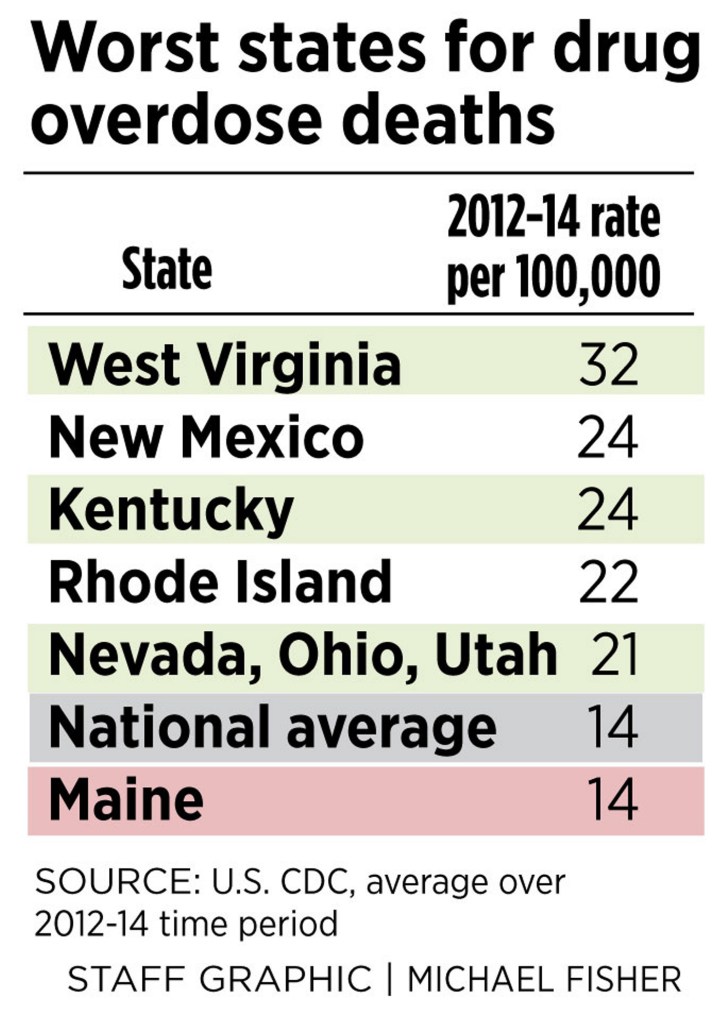Drug overdose deaths are soaring in Maine and across the United States, but the per-capita rate of deaths – fueled by the heroin epidemic – varies widely depending on where people live.
In Maine, residents in Washington and Waldo counties are far more likely to die of drug overdoses than people living in Aroostook and Oxford counties, according to data from the U.S. Centers for Disease Control and Prevention that was highlighted in the County Health Rankings report released Wednesday. The report – compiled by the University of Wisconsin – rates counties across the U.S. on health measurements including cancer, smoking, obesity, alcohol consumption and infant mortality. This is the first year that the County Health Rankings include data on drug overdose deaths.
Public health experts are puzzled over the regional variation in overdose deaths, because there doesn’t seem to be a clear-cut reason why Midcoast and Down East coastal counties have experienced about twice as many per-capita deaths as inland rural counties in Oxford and Aroostook.
“I don’t think anyone knows why,” said Deborah Deatrick, senior vice president of community health for MaineHealth, the parent company of Maine Medical Center. Maine’s per-capita drug overdose death rate – 14 per 100,000 people from 2012-14 – matches the national average. However, for 2015 the per-capita rate in Maine was 21 per 100,000 residents.
States suffering from much higher rates of overdose deaths include West Virginia at 32 per 100,000, New Mexico and Kentucky at 24 and Rhode Island at 22 over the three-year period.
In Maine, per-capita overdose deaths ranged from highs of 20 and 18 in Washington and Waldo counties, respectively, to lows of 10 and eight in Aroostook and Oxford counties.
Cumberland County – Maine’s most populous county and home to its biggest city, Portland – had the most deaths over three years, 132, but the per-capita rate was near average at 15 per 100,000.
ASSESSING DIFFERENT DEATH RATES
Brent Miller, program director at Discovery House Bangor, a substance abuse treatment center, said it’s difficult to determine why the overdose death rate varies, but lack of access to treatment in the remote coastal regions of Maine, coupled with poverty and the industries that people work in, could be contributing factors.
“Are these areas where people are smuggling in the drugs?” said Miller, who recently also headed up the Discovery House branch in Calais, in Washington County. “There’s a lot of possibilities.”
Tim Cowan, director of MaineHealth’s Health Index Initiative, said having access to the heroin antidote Narcan also could be a factor.
Per-capita ambulance responses to drug overdoses – measuring responses per 10,000 residents – were about double the rate in Cumberland County as they were in Down East Maine, which includes Washington County, according to Maine Emergency Medical Services.
Administering Narcan is a common way to save people from dying from a drug overdose, and response times are much longer in rural areas than in, say, Portland, meaning paramedics might not arrive in time to use the heroin antidote.
Even so, Washington County residents received an amount of paramedic-delivered Narcan per capita similar to Cumberland and York counties – according to state statistics – while at the same time experiencing a higher rate of overdose deaths.
The industries that people work in also could be a contributing factor, Miller said. People who fish for a living experience a lot of workplace injuries, and the industry has the second-highest fatal accident rate, according to the U.S. Bureau of Labor Statistics. Logging – another Maine staple – had the highest rate of workplace fatalities.
People who are injured are often prescribed painkillers, and opioid prescription abuse is a gateway to heroin usage, according to the American Society of Addiction Medicine. Four of five new heroin users were first addicted to prescription painkillers, according to the society.
Some public health experts have linked the grueling physical labor in the coal industry with the surging opioid deaths in Appalachia, including West Virginia and Kentucky.
MAINE LIKELY TO RANK HIGH IN 2015
The LePage administration is proposing new rules that would greatly reduce the number of prescription opioids in Maine by putting more restrictions on physicians. Other bills before the Legislature seek to combat the heroin epidemic in a number of ways, such as more drug enforcement agents and expanded access to treatment.
Statewide, drug overdose deaths have increased substantially in Maine, from 208 in 2014 to 272 last year.
Cowan, with MaineHealth’s Health Index Initiative, said the federal CDC doesn’t yet have the 2015 data from all the states, but when it does in the late fall or early winter, he believes Maine will be much higher on the list of states suffering from higher rates of overdose deaths.
“What I’ve seen so far is that Maine’s increase (in 2015) has been more dramatic than other states that are reporting 2015 numbers,” Cowan said.
The MaineHealth 2015 Health Index Report – also released Wednesday in conjunction with the County Health Rankings – looks at a number of health measurements. While drug overdose deaths increased, the state performed better on other measures, including improved vaccination rates among toddlers, reduced smoking rates and a stable obesity rate.
Deatrick, the MaineHealth vice president, said the heroin epidemic is a top public health priority.
“It’s such a fast-moving problem,” she said. “We have to get a handle on this and do something quickly.”
Send questions/comments to the editors.





Comments are no longer available on this story